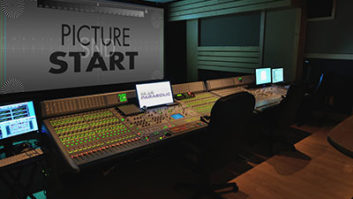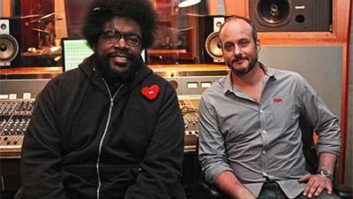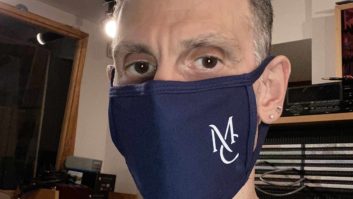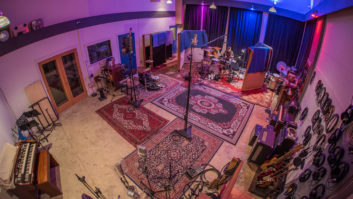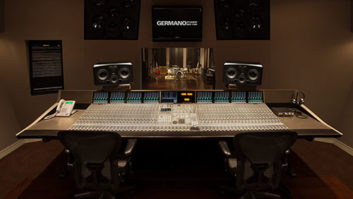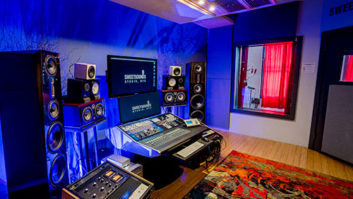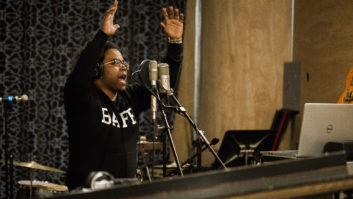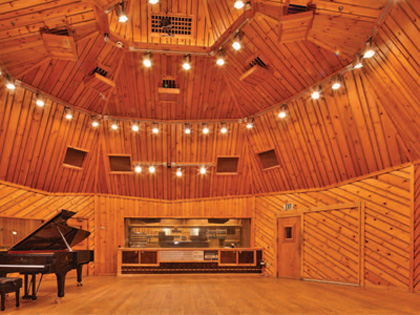
THE POWER STATION AT BERKLEENYC
Historic Studio’s Next Act
As widely reported by the New York Times and others, Berklee College of Music, led by president Roger Brown and trustee Peter Muller, has joined with the City of New York to acquire Avatar Studios. Through this partnership, the studios that were originally built by producer Tony Bongiovi and co-founder Bob Walters in the late 1970s, will receive selective upgrades and play a new educational role for Berklee students and for New York’s audio and music communities. Leading these efforts is Berklee’s Dean of Strategic Initiatives, Stephen Webber. An educator, musician and recordist, Webber had just headed up the launch of Berklee’s Valencia, Spain, campus when he was asked to make Power Station at BerkleeNYC his next priority.

Stephen Webber will serve as Executive
Director of Power Station at BerkleeNYC
“As someone who’s been in recording all of my life, it means a great deal to save these studios,” Webber says. “There’s something that happens when people come together in an inspiring space to make music together, and I feel like that is something worth preserving.”
Good news for Avatar’s devoted clientele: Chief engineer Roy Hendrickson will stay on with Berklee, and the famed acoustics of the original studios and the vintage equipment within the building—including consoles, mics and outboard gear—will remain intact. “But at the same time, the Pro Tools systems haven’t been upgraded in ten years, and there’s a lot to do in terms of networking,” Webber says. “We will also outfit all the studios with cutting-edge video-capture technology and add a video control room in the lower level, which is currently massively underutilized.”
Further plans for the lower floor of the building include installation of a rehearsal/performance space and a virtual reality laboratory “We want this to be a hub of creative activity,” Webber says. “We want it to be this amazing space where collaboration and community and innovation can’t help but happen when you walk in the door.”
“There’s also been a lot of interest from people in continuing education for musicians, producers, engineers and technologists,” Webber says. “We want to use this space as a laboratory to come up with new ideas for classes and programming. We want to look back 10 or 20 years from now and say this was a real turning point in music education and the New York studio scene.”Once Berklee has completed renovations—which will also involve an architectural facelift to the building exterior—the studios will operate under a similar business model to the one used by Ocean Way Nashville/Belmont University, where educational institutions, including Berklee, local schools and community groups, will book time as commercial clients do. Educational programming will be supported to some extent by a $6 million investment by the City of New York. Berklee may also offer some of its students an opportunity to spend their last semester in New York.

Engineer Ben Wollner (left) and Keyon
Harrold at Shelter Island Sound
Keyon Harrold at Shelter Island Sound
The album features guest appearances by Bilal and Gary Clark Jr., and a sound that merges sweet, pure jazz trumpet music with electronica.
A Grammy-winner for his work on the Miles Ahead soundtrack, as well as Gregory Porter’s Take Me to the Alley, trumpeter/producer/songwriter Keyon Harrold has just released his latest solo album, The Mugician (Legacy/Mass Appeal Records).
A variety of engineers, including Mick Guzauski and Glen Marchese, mixed the album tracks, but the majority of the tracking was done live at Shelter Island Sound with producer Harrold and engineers Myles Turney and Ben Wollner.
“Shelter Island is a studio where I work at a lot,” says Wollner. I like it because it’s a very private facility and it combines modern technology—Pro Tools 11 and AD/DA conversion—with an MCI/API 636 board and a lot of Neve pre’s and that sort of thing. Also, the backline is great: there’s a great piano, a B-3 that sounds amazing, Wurlitzer, Rhodes, and those things made it great for this project.”
Harrold’s trumpet is the centerpiece of the album, and one of the pieces that went down live. “I would usually put three mics up: a Royer or a Coles ribbon mic into a Neve 1081 or 1073 preamp, a Neumann M49 through a Hardy M1 pre, and an AKG C12 through another Neve pre. If need be, I would compress with an LA2A, but I would try to avoid compression as much as I could.”
THE STUDIO LETTER OF THE DAY IS “G”

While the owners of Studio G—musician/engineer/ producers Joel Hamilton, Chris Cubeta and Tony Maimone—are proud of their rock records and multiple Grammy nominations, they’re also pleased to host ongoing music production for the under-5 set.
“We’re now the head- quarters for all the music for Sesame Street,” Hamilton says. “They’re here every Tuesday using our B room. They have a consistent band and the same producer, Bill Sherman, who also produced the Hamilton soundtrack album. All the Hamilton cast members’ individual albums have been happening in Studio G as well, under Bill’s production.”
Studio G’s 1,000-square-foot B room features a 40-channel Neve 5316 console that was originally used by the BBC. “They use all of our vintage micro- phones. We have a really extensive vintage synth and drum machine collection, as well, and that’s been expanding like crazy recently,” Hamilton says.
Other recent projects at Studio G include Cubeta working with indie pop duo A Great Big World, and Hamilton with Turkish pop singer Sertab Erener.
DOUGLASS RECORDING, FROM L.A. TO NYC

Douglass Recording opened this year, built into 2,000 square feet of warehouse space in Brooklyn’s Park Slope neighborhood. Owner/engineer Myles Rodenhouse is a native New Yorker with an L.A. connection: His brother, Jake, owns two studios out west, and
the siblings collaborate frequently, sharing clientele, knowledge and gear. Myles’ studio was designed by the late Vincent Van Haaff, who had con- sulted on Jake’s studio Perfect Sound. “He designed the layout and most of the acoustic treatment before he passed away in 2016,” says Myles, who makes
no apologies for wanting to emulate what his brother has established in L.A. “There’s tons of stuff that we ripped right out of Perfect Sound. I got to know a lot of that equipment, and wanted to create a similar vibe. I actually acquired speakers from Perfect Sound. They’re Barefoot Micromain 27s.” Douglass also offers Pro Tools 12, Digital Performer and racks of Neve preamps and choice outboard gear. “We chose to do a hybrid sort of thing without a traditional console,” Myles says. “We also do a lot of work with plug-ins, inside the box, of course. Something we’re especially proud of is the keyboards.” Myles is a pianist, and he’s particularly happy with his Steinway B, which is maintained by James Carney. The studio also offers a vintage Rhodes piano, as well as a Wurlitzer 200A and Hammond organ restored by Vintage Vibe. Clients that have worked at Douglass Recording recently include Talib Kweli with engineer Chris Pummill, pianist Arturo O’Farrill and vocalist Grace Mitchell.
SESSIONS

Joey Wunsch, Daniel Sanint, James Bay and Jonathan Green
FLUX STUDIOS, NYC
Recent sessions in the multiroom Flux Studios include Andre 3000 with engineer Ken Oriole, Ingrid Michaelson recording “Miss America” (Sara Bareilles) with engineer Daniel Sanint and assistant engineer Ana Tuiran, and Sanint and assistant Joey Wunsch capturing James Bay’s writing session with Jonathan Green.

Manhattan Center Productions
MANHATTAN CENTER PRODUCTIONS
Obie O’Brien, studio manager of MCP, reports, “We just finished recording and mixing a film score with composer Elliot Goldenthal for an upcoming Netflix movie called Our Souls at Night, starring Robert Redford and Jane Fonda. It was our first film project to be recorded and mixed in our recently renovated Studio 7. We also recently hosted MixCon which was spread between our Grand Ballroom, the new Studio 7 and our Log Cabin studio.” Gear in MCP’s new studio 7 includes an 80-fader Lawo mc256 console, Pro Tools 12 and ATC SCM110 Monitors.

Nathaniel Reichman & Tony Mason
RHUMBA, NYC
Rhumba is the children’s entertainment arm of Murmur Music/ Dubway Studios. Ongoing work includes composing and recording songs for the new animated Barbie preschool series Dreamtopia. The Rhumba staff also took charge of casting, directing, scoring, sound designing and mixing Season Isle and Remy’s Place for Panoply’s children’s division, Pinna. Tracking songs live for Remy’s Place were musicians Richard Julian, Norah Jones, Henry Butler, Matt Munisteri, Tony Scherr, Kenny Wollesen, Tony Mason and Roy Nathanson, with Brad Jones engineering.

The Cast of Waitress
THRESHOLD STUDIOS, NYC
Threshold Studios owner/producer James Walsh reports that his studio has hosted recent sessions to create marketing music with a number of Broadway cast members, ensembles and shows, including Something Rotten!, Waitress and Kinky Boots. Threshold’slatest projects also include Cyndi Lauper with engineers Andrew Yanchyshyn and Walsh, and producer Bill Whittman; and John and Roger Taylor of Duran Duran cutting a song to benefit the nonprofit Road Recovery, with Walsh engineering and co-producing with the Taylors and Scott Young.
